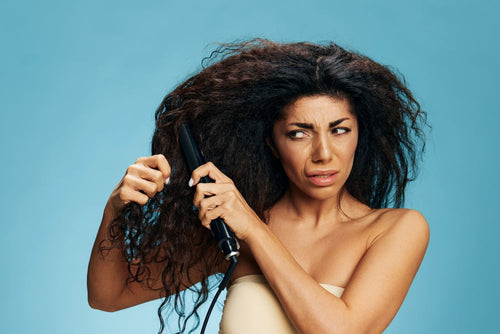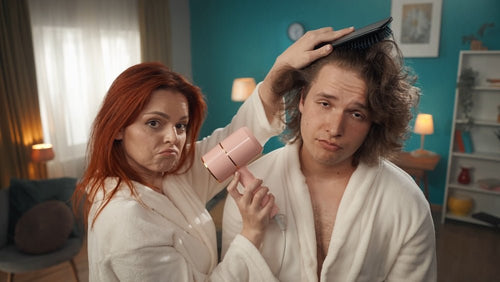Introduction
If your hair always seems to repel moisture, takes forever to dry, or feels product-heavy no matter what you use—chances are, you have low porosity hair.
While often overlooked in mainstream hair care conversations, porosity plays a crucial role in how well your hair absorbs and retains moisture. And understanding it can be a game-changer in achieving healthier, more manageable hair.
This guide will walk you through everything you need to know about low porosity hair, from how to tell if you have it, to choosing the right products and building a routine that works day and night.
Whether you're new to the term or looking to refine your regimen, this guide offers science-backed, practical advice to unlock your hair's true potential.
What Is Low Porosity Hair — and How to Tell If You Have It?
Hair porosity describes how well your strands can take in and hold onto moisture. This trait is influenced by the state of the cuticle layer, which forms the outer surface of each hair shaft.
Low porosity hair has tightly closed cuticles that make it difficult for moisture to enter, but once it does, the hair tends to retain it well.
Signs You Have Low Porosity Hair:
- Water beads up on your hair instead of soaking in
- Hair takes a long time to dry naturally
- Product buildup is a constant issue
- Protein-heavy products make your hair feel stiff
- Your strands feel smooth when you run your fingers down them
Try This Simple Test:
If you want to find out if you have low porosity, medium porosity or high porosity hair, just do like this. Place a clean, dry strand of hair into a glass of water. If it floats for several minutes without sinking, you likely have low porosity hair.

Common Hair Struggles for Low Porosity Types
Caring for low porosity hair comes with its own set of challenges:
- Moisture resistance: Products often sit on the surface rather than being absorbed.
- Product buildup is a common concern—especially when using thick oils, dense butters, or formulas rich in protein, which tend to sit on the hair and leave it feeling heavy or coated.
- Dry but greasy-feeling roots: Because moisture isn't absorbed, your scalp may overproduce oil.
- Stiffness and lack of bounce: Without proper hydration, hair feels brittle despite using moisturizers.
These challenges often make people think their products aren't working, but it's not the product—it's the porosity.
Your Daily and Nighttime Routine for Low Porosity Hair
Morning Routine:
1. Start with Steam or Warm Water
- Use warm water to open the cuticle before applying any products.
- Alternatively, use a steamer or warm towel to prep your hair.
2. Use a Lightweight Leave-In Conditioner
Avoid thick creams. Go for liquid-based moisturizers with humectants like glycerin or honey.
3. Seal Lightly
Apply a few drops of lightweight oils like argan or grapeseed to lock in hydration.
4. Style with Minimal Product
Use water-based gels or creams sparingly. Less is more for low porosity hair.
Nighttime Routine:
1. Hydrate Lightly
If your hair feels dry, lightly mist it with a leave-in or distilled water.
2. Pineapple or Loose Braid
To preserve curls or waves without creating tension.
3. Sleep with a Satin Bonnet or Pillowcase
Protects your hair from friction and prevents moisture loss.
10 Best Low Porosity Hair Products
When choosing low porosity hair products, look for lightweight, protein-free, and moisture-boosting formulas. Here are 10 editor-tested picks:
1. Kinky-Curly Knot Today Leave-In Conditioner
This cult-favorite leave-in is a top choice for low porosity naturals. Its creamy yet lightweight texture glides through knots and tangles with ease, making detangling a breeze.
Formulated with slippery elm, marshmallow root, and lemongrass, it provides just the right amount of moisture without overwhelming fine strands.
Why it works: It's silicone-free, protein-free, and full of natural slip—ideal for low porosity curls that need hydration without buildup.

2. Camille Rose Curl Love Moisture Milk
Infused with rice milk, macadamia seed oil, and aloe vera, this luxurious moisture milk is beloved for its softening and shine-enhancing properties. Despite being a "milk," it feels incredibly lightweight and melts right into the hair shaft.
Why it works: The combination of humectants and light oils makes it perfect for daily moisture without clogging the cuticle layer.

3. Bonnet Queen Satin Bonnet
Yes, it's not a styling product—but it's just as essential. Using a satin bonnet at night helps reduce moisture loss, minimize friction, and maintain your hair's style without frizz. Bonnet Queen's adjustable double-layer satin bonnet is designed with low porosity needs in mind—protective, breathable, and stylish.
Why it works: Retains hydration overnight, prevents tangling, and supports long-term moisture retention in low porosity hair.

4. Aunt Jackie's Quench Moisture Intensive Leave-In
One of the most budget-friendly yet effective products on the market, this glycerin-rich formula delivers lasting hydration. It also contains shea butter in a diluted, non-heavy concentration—suitable for low porosity textures.
Why it works: Glycerin is a top humectant that draws moisture into the hair, and this product is balanced enough to work without overwhelming the hair shaft.

5. Aloe Vera Juice Spray (DIY or Store-Bought)
Aloe vera juice is a natural, pH-balancing treatment that helps open the hair cuticle slightly, allowing better moisture absorption. It can be used as a daily mist, a base before applying products, or even mixed with a few drops of essential oils for added benefit.
Why it works: Aloe vera helps soften the cuticle and balance scalp health—critical for ensuring your low porosity hair actually absorbs what you put on it.

6. Tropical Moringa Sweet Oil & Honey Daily Moisturizer by The Mane Choice
This moisturizer is light yet nourishing, thanks to moringa oil, honey, and biotin. It helps soften dry strands and improve elasticity without causing buildup. Plus, it smells amazing!
Why it works: It delivers lasting moisture while remaining buildable—great for twist-outs, braid-outs, or daily maintenance.

7. Eco Styler Gel with Olive Oil
Styling low porosity hair often means finding gels that won't flake or harden too aggressively. This olive oil version of Eco Styler offers great hold with added moisture, minus the crunch.
Why it works: It provides definition and control while being water-based, meaning it won't clog the cuticle or cause flakes when used moderately.

8. As I Am Curl Clarity Shampoo
Low porosity hair tends to accumulate product on the surface, so regular clarifying is essential. This shampoo cleanses without stripping, making it a gentle yet effective reset button.
Why it works: Sulfate-free but strong enough to break through buildup—ideal for those who use leave-ins, stylers, and oils regularly.

9. Giovanni Direct Leave-In Weightless Moisture Conditioner
Formulated with botanical extracts and no silicones, this weightless leave-in delivers hydration to fine, low porosity strands without making them greasy. A favorite among minimalists.
Why it works: Its clean, simple formula ensures your hair gets what it needs without excess weight, making it a go-to for refresh days or low-manipulation styling.

10. Mielle Organics Pomegranate & Honey Leave-In Conditioner
Designed with Type 4 hair in mind but loved across curl types, this leave-in conditioner offers slip, moisture, and definition. It's free of heavy proteins, making it safe for low porosity hair that's protein-sensitive.
Why it works: The pomegranate extract helps soften hair, while honey acts as a natural humectant, drawing in moisture.

FAQs About Low Porosity Hair
Q: Can low porosity hair grow long?
A: Yes! In fact, low porosity hair tends to retain moisture better once it's absorbed, which helps reduce breakage over time. The key is consistent care and gentle handling.
Q: How often should I wash low porosity hair?
A: About once a week. Focus on cleansing the scalp thoroughly and avoiding heavy products in between washes to prevent buildup.
Q: Should I avoid protein completely?
A: Not necessarily. Occasional protein can be beneficial, especially hydrolyzed proteins in small amounts. But for weekly use, go protein-free.
Q: What ingredients should I avoid?
A: Avoid waxes, heavy butters, silicones, and high-protein products. These tend to sit on top of the hair shaft and cause buildup.
Final Words: Embrace Your Low Porosity Hair
Caring for low porosity hair isn't about following generic routines—it's about understanding how your unique hair works and giving it what it truly needs.
Once you master the balance between moisture, light products, and protection, your hair will feel softer, look shinier, and become much easier to manage.
Start by simplifying your routine, investing in the right products, and sticking with it. Your hair will thank you.



